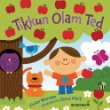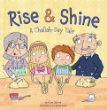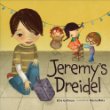Books
Fiction
Books: Kid’s Stuff: Dinosaurs, Watermelons and Jackie Robinson
November—Jewish Book Month—provides the opportunity to discover and explore the latest offerings geared to young readers. These newly published works include lighthearted, gaily illustrated picture books, sensitively told tales of courage and compassion during the dark days of the Holocaust as well as insightful and whimsical fiction of adolescent and preadolescent angst at summer camps and middle schools.
 A trio of highly bite-able board books (all from Kar-Ben Publishing, 12 pp. $5.95 each) will engage the not-yet-ready-to-read set and introduce toddlers to the joys of Tu B’Shvat, Hanukka and Shabbat: Tikkun Olam Ted
A trio of highly bite-able board books (all from Kar-Ben Publishing, 12 pp. $5.95 each) will engage the not-yet-ready-to-read set and introduce toddlers to the joys of Tu B’Shvat, Hanukka and Shabbat: Tikkun Olam Ted by Vivian Newman and illustrated by Steve Mack, Eight Is Great
by Tilda Balsley and illustrated by Hideko Takahashi and Thank You, Trees!
by Gail Langer Karwoski and Marilyn E. Gootman and illustrated by Kristen Balouch. Ages 1-4.
It’s Sesame Street time with a Jewish dimension in It’s a Mitzvah, Grover! by Tilda Balsley and Ellen Fischer (illustrations by Tom Leigh; Kar-Ben Publishing, 24 pp. $16.95 cloth, $6.95 paper). Grover and his Israeli pals help to repair the world by cleaning a neighborhood playground and recycling tin cans. The familiar Sesame Street gang learns that doing a mitzva can also mean having fun. Ages 1-4.
From A (for Antiochus) to Z (zzz before Hanukka dreams), each letter in ABC Hanukkah Hunt by Tilda Balsley (illustrated by Helen Poole; Kar-Ben Publishing, 32 pp. $17.95 cloth, $7.95 paper) celebrates the joyous Festival of Lights. Ages 3-8.
 When Sam and Sophie find a recipe in Yiddish for halla, they bring it to Grandma Gert at the Shalom House, which spurs Grandma and her coterie of elderly friends to join them in a baking spree. The sweet message of Rise & Shine: A Challah-Day Tale
When Sam and Sophie find a recipe in Yiddish for halla, they bring it to Grandma Gert at the Shalom House, which spurs Grandma and her coterie of elderly friends to join them in a baking spree. The sweet message of Rise & Shine: A Challah-Day Tale by Karen Ostrove (illustrated by Kimberly Scott; Kar-Ben Publishing, 24 pp. $17.95 cloth, $7.95 paper)—an equally sweet rhyming story—is that old folks can be funny, energetic and excellent bakers of the delicious Shabbat bread. Ages 3-8.
In A Watermelon in the Sukkah (Kar-Ben Publishing, 24 pp. $17.95 cloth, $7.95 paper) by Sylvia A. Rouss and Shannan Rouss, Michael’s classmates bring their favorite fruits to decorate their sukka, but Michael’s favorite fruit is watermelon, which creates a dilemma for the children and their teacher as they struggle to find a way to hang it. Do they succeed? Ann Iosa’s drawings of smiling faces hint at the answer. Ages 3-8.
It looks like a disastrous Rosh Hashana for Harry’s family, with a move to a new town, a flat tire and only pizza on the festival menu. Jacqueline Jules’s What a Way to Start a New Year!: A Rosh Hashanah Story (illustrated by Judy Stead; Kar-Ben Publishing, 24 pp. $16.95 cloth, $7.95 paper) shows how an invitation to a new synagogue and then to a meal complete with brisket, a round halla, apples and honey save the day—and teach Harry the important mitzva of welcoming guests. Ages 3-8.
 Rifka, the charming young daughter of Yiddish actors, makes a surprise appearance on the stage of the famed Second Avenue Theatre, and the delighted audience rewards her with wild cheers and enthusiastic applause. Rifka Takes a Bow
Rifka, the charming young daughter of Yiddish actors, makes a surprise appearance on the stage of the famed Second Avenue Theatre, and the delighted audience rewards her with wild cheers and enthusiastic applause. Rifka Takes a Bow (Kar-Ben Publishing, 32 pp. $17.95 cloth, $7.95 paper) is a look at the lost world of the vibrant Yiddish theater, brought to life by Betty Rosenberg Perlov’s words and Cosei Kawa’s lovely, quirky illustrations. Ages 3-8.
Tania Grossinger often felt lonely during her childhood in her family’s famous hotel, so she was thrilled when Jackie Robinson, an honored guest, invited her to play Ping-Pong with him. In Jackie and Me: A Very Special Friendship (illustrated by Charles George Esperanza; Sky Pony Press, 32 pp. $16.95), she does not remember who won that initial match but she does remember that the great African-American Brooklyn Dodger, who endured racial taunts on the baseball diamond, advised her “to never be ashamed of who you are.” Their friendship lasted until Robinson’s death and remains a treasured memory that Grossinger shares with her young readers. Ages 4-up.
A small boy learns to cope with the death of a beloved grandfather when the custom of placing stones on his tombstone is explained to him at the traditional unveiling. Stones for Grandpa (Kar-Ben Publishing, 24 pp. $17.95 cloth, $7.95 paper) by Renee Londner and illustrated by Martha Avile, show how the custom, accompanied by stories of his grandfather’s life, both comforts and consoles. Ages 5-8.
 In Jeremy’s Dreidel (Hanukkah)
In Jeremy’s Dreidel (Hanukkah) (Kar-Ben Publishing, 32 pp. $17.95) by Ellie Gellman and illustrated by Maria Mola, attending a dreidel workshop, Jeremy learns that the Hanukka top can be made of wood and clay, that it can be fashioned out of rubber and recyclable materials, and that there are even singing dreidels. Most important of all the letters can be designed in Braille, so that Jeremy’s blind dad can feel the nun, gimel, hey and shin that tell him of the great miracle that informs the holiday. Ages 5-9.
The important question posed by the title of Jane Yolen’s book—How Do Dinosaurs Say Happy Chanukah? (illustrated by Mark Teague; Blue Sky Press, 40 pp. $16.99)—is answered in delightful rhymes that wonder how various dinosaurs observe the holiday. Surely they “don’t snatch away dreidels so no one plays and do this for each of the eight holy days.” No, of course they do not, but they do have a marvelous time as dreidels tumble and gelt melts as mischievous Dracorex and Nodosaur and other colorful prehistoric creatures frolic through the festival season. Ages 5-up.
 German Jewish brothers Abraham and Zadok Staab, who immigrated to America in search of freedom and prosperity, are the focus of Jews of the Wild West a Multicultural True Story
German Jewish brothers Abraham and Zadok Staab, who immigrated to America in search of freedom and prosperity, are the focus of Jews of the Wild West a Multicultural True Story, written, illustrated and self-published by Kay Miller (14 color illustrations; Paint Horse Press, www.jewsgowest.com, 32 pp. $9.95). By dint of their courage and perseverance, the Staabs found success in Santa Fe. Active in banking and railroads, and generous to their non-Jewish neighbors, the family hosted dignitaries including governors and President Rutherford B. Hayes as well as Hopi Indians. Their children married into other Jewish families and created a vibrant and loving community that helped “make New Mexico a better place to live, work and play.” Ages 8-up.
Tales for Jewish Children (Bunim and Bannigan, 58 pp. $23.95) is a collection of classic folk stories that delighted Jewish children in the earlier and happier years of the twentieth century. Ilse Weber’s book comprises tales that were serendipitously discovered and tenderly translated by Ruth and Hans Fisher, themselves fortunate escapees from Nazi Germany. The legendary Mendel Rosenbach, the fictional protagonist, is vested with the ability to make himself invisible and thus able to transfer hallot from the pantry of a rich household to the oven of poor, overworked 11-year-old Rivka. He could also make food fly to the table of a poor ailing widow and organize a birthday party for generous and kind Aunt Hanni. The stories are delightful, the translation effortless and the illustrations are, as artist P. John Burden writes, “dark with always a light shining through”—like the tales themselves. Ages 8-up.
 Elementary school students in Canada contributed essays, stories and drawings to We Are Their Voice: Young People Respond to the Holocaust (Holocaust Remembrance Book for Young Readers)
Elementary school students in Canada contributed essays, stories and drawings to We Are Their Voice: Young People Respond to the Holocaust (Holocaust Remembrance Book for Young Readers) (Second Story Press, 160 pp. $14.95). The volume, edited by Kathy Kacer, describes the impact of the Holocaust on the lives of the children, each entry marked by a determination to speak for those whose voices were stilled and to confront a painful past with hope and compassion.
Imagined diary revelations by a girl who wonders whether she should conceal her religious identity for safety, interviews with survivors and wrenching drawings are offset by important lessons. An eighth grader confides that a photograph of “a Jewish man lying on the ground with Nazis standing over him” taught her “how important it is to do the right thing and speak out against bullying.” A seventh grader hopes that this project “will prevent history from repeating itself.” A caveat to parents and teachers—some of the graphic material may upset sensitive young readers and should be approached with adult guidance. Ages 9-up.
 In The Path of Names
In The Path of Names, author Ari Goelman (Arthur A. Levine Books, 352 pp. $16.99) has placed Dahlia Sherman, who loves magic, in Camp Arava, where her parents hope she “will meet some Jewish kids.” Interspersed with the camp experience (bad food, mean girls, odd pranks—some more amusing than others) are flashbacks to a previous era when a boy named David, like Dahlia a math and magic aficionado, was embroiled in a mysterious kabbalistic experience. There are ample and intriguing references to dybbuks, gematria and golems as well as the 72 names of God, coupled with the familiar rhythms of Jewish camp life. The intriguing, skillfully told tale has an improbably happy ending and, yes, the reluctant camper makes friends with some very interesting Jewish kids. Ages 10-up.
In January 1941, when the Nazis marched into Krakow, Yanek Gruener was a bright 12-year-old schoolboy, spoiled by his parents and anticipating his bar mitzva. Six years later, he is a survivor of 10 concentration camps and his beloved family has vanished into the abyss of Nazi-occupied Poland. His wartime identity is tattooed on his arm; as the title informs us—he is Prisoner B-3087 (Scholastic Press, 260 pp. $16.99). Taking occasional liberties with the true story of his impressive subject now known as Jack Gruener, authors Alan Gratz and Ruth Gruener recount terror tales of the camps as well as vignettes of the valiant victims. Transferred from one work camp to another, young Yanek’s name is lost but he retains his humanity, his courage and his tenacity, promising himself that he “will not go like a sheep to slaughter.” It was a promise that he kept in Birkenau (thus the letter B), as he joined a minyan for a clandestine bar mitzva; at Auschwitz, where he survived a “selection” by the infamous Josef Mengele; and during death marches until the miracle of liberation by American troops. Ages 10-up.
 It is easy to see how Leanne Lieberman’s tale got the title Lauren Yanofsky Hates the Holocaust
It is easy to see how Leanne Lieberman’s tale got the title Lauren Yanofsky Hates the Holocaust (Orca Book Publishers, 240 pp. $12.95 cloth, $10.25 paper). Lauren, an escapee from what she calls “Hebrew school hell,” is happily enrolled in a secular high school and friendly with a group of A-list girls whom she calls “the perfects.”
Given that her father is a Holocaust historian, she has overdosed on Jewish tragedy, having spent vacations visiting the Holocaust museum in Washington, D.C., Yad Vashem in Jerusalem and concentration camps. She has also decided to become a “non-Jew by choice,” explaining that “Some kids got Disney, I got Hitler.” Her idyllic school life crashes when her classmates, including her special crush, Jess, play Nazi war games. Lauren must make a decision that will challenge her past and mold her future. She is also witness to her younger brother’s pre-bar mitzva anxiety. The author skillfully blends suspense and humor as Lauren navigates her way through a complex dilemma. Ages 12-up.
 Greenhorn
Greenhorn by Anna Olswanger (illustrated by Miriam Nerlove; NewSouth/Junebug Books, 48 pp. $17.95), based on a true event, is the touching story of Daniel, traumatized into muteness by the Holocaust, and Aaron, a bullied stutterer, who are thrust together in an Orthodox yeshiva in Brooklyn in the 1940s. Daniel, a precocious Torah scholar, clutches a tin box that Aaron helps him protect. When the contents of the box are dramatically and tragically revealed, the boys are bonded in a tender and enduring friendship. Ages 12-up.
Gypsies as well as Jews were the targets of Nazi hatred and persecution. In her moving, splendidly researched fictional narrative The Extra (Candlewick Press, 320 pp. $16.99), Kathryn Lasky tells the story of 15-year-old Lilo, a Gypsy girl. Leni Riefsenthal, Hitler’s cinematographer, chooses Lilo to act in a movie even as her extended family is being exterminated. The technicalities of filmmaking, the grim irony of beauty masking evil, Lilo’s courage and ingenuity as she endures the horrors of Buchenwald, her dramatic escape and ultimate rescue make for poignant and suspenseful reading. Ages 12-up.










 Facebook
Facebook Instagram
Instagram Twitter
Twitter
Leave a Reply